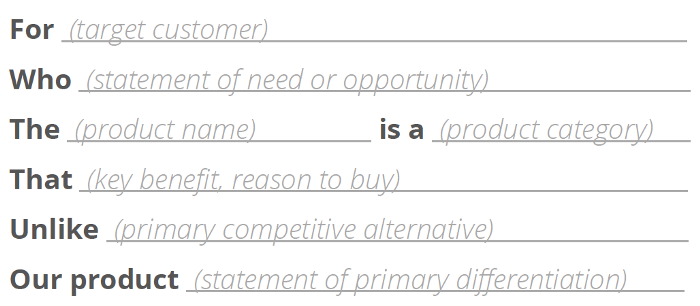Product Vision
Before we dive into some tips on the Product vision, let's provide a little context first! The Product Owner is the one person in Scrum who is responsible for the success of the Product. Therefore, the Product Owner creates, manages, and owns the Product vision. The Product vision describes the purpose of a Product, the intention with which the Product is being created, and what it aims to achieve for customers and users. The Product vision describes a future state of the Product and what problems it tries to resolve or what ambitions it tries to fulfill.
Having a clear and inspiring Product vision helps in motivating and inspiring people, like the Scrum Team, the stakeholders and customers, and users. It also provides a common understanding of the direction we want to move towards. Besides that, the Product vision also supports the Product Owner in making choices about what to build and what not to build for the Product.
All in all, it's pretty damn important to have a Product vision, so in this blog, we'll cover 10 tips about the Product vision. Also, check out my other blogs with tips for the Product Owner (see the links at the end of this blogpost). I hope you enjoy them!
10 Tips for your Product vision:
1. Be(come) the owner of the Product vision
In my humble opinion, this is by far the most important tip we can share with you. We have met, coached, and trained many, many, many Product Owners and the most successful Product Owners we've met were really passionate about their own Product Vision. We've also met a lot of Product Owners who didn't own the vision, but who were mainly executing the product roadmap, based upon someone else's vision. This makes the job harder, not impossible, but a lot harder. This is mainly because as a Product Owner, you should be motivated by the vision, your heart should start beating faster about it, you should be passionate about the vision and you have to share it, very very often. Product Owners that own the vision and are passionate about it, are typically more successful.
2. Share your Product vision, often
Your job as a Product Owner includes sharing the Product Vision. And sharing the vision again. And again. And again. It is soooo important for people to know why you're doing the things you do. It helps the Developers in making technical choices about architecture for example. It helps the stakeholders in understanding what would be valuable for the product. It helps users to understand why they should use and/or buy your product. The Product Vision is just so damn important!
3. Don't believe your idea is the best idea ever
Being passionate about your Product is awesome! There is one downside to passion, however. We've met quite a few Product Owners who were so much in love with their own Product, that they forgot that they weren't developing the Product for themselves, but for their customers and users. So don't fall into this trap. I'm sure your product idea(s) are awesome, but keep in mind that you're building the Product for someone else. To put it differently, don't think your idea is the best idea ever. Make sure that you validate your vision with stakeholders, the market, users, etc., etc. And release the Product early and often, to get feedback from the users.
4. Develop your vision iteratively and incrementally
Developing an awesome Product Vision is rather complex. It's not predictable, nor easy, nor something you do 'first time right'. It's also not something you should do on your own. So in order to develop the Product vision, collaborate with your stakeholders, Scrum Team, customers, and users! Also, don't try to get it right the first time! Take a couple of iterations to improve your vision. Make it better over time!
5. Adapt your vision as you're learning
Another important tip we would like to share is: 'Don't be afraid to pivot!'. Some of the most successful Products (of recent years) like Facebook, Post-it and Netflix started out with a totally different purpose (vision) in mind. Only because the original purpose failed and the companies adapted their vision, they have now become some of the most successful companies of our time. So don't be afraid to change direction! As you're learning from customers and users, adopt their feedback, and embrace that changing your vision might just be a great idea!
6. Adapt your vision pitch, based upon your target audience
Since you are sharing your vision so often, with many different types of audiences, you should make a tailor-made pitch for your different stakeholder groups! In your pitch, make sure to address the things that are important for them. For some stakeholders, you mainly need to report about the KPI's that are relevant to them. For other stakeholders, you need to be the inspiring (Product) leader, who is representing the Product. And for another group, you may need to focus more on the benefits of the Product for them. So tailor your pitch to your audience!
7. Focus on value for customers and users, not on technology
A good vision is inspiring, motivating, and inviting. An inspiring vision often isn't built around technology or features (there are exceptions of course). It's about resolving a problem or about achieving a dream. So don't make your Product vision (too) technical, focus it around the business (value).
8. Keep your vision short, clear, and inspiring
A good vision is inspiring for people. It's a description of a dream, of a state to become. It's a dot on the horizon that you're working towards. It's also stretching for people. On the other side, a vision statement should also be short and clear for people. By short and clear we don't mean short term. It should be a dream for the long term, but people also need to be able to understand the vision, so it should offer clarity. A nice way to start with your vision statement is by using the vision statement template (see below). Beware: it's just an example to get you started, you don't have to force your vision into this template!

9. Make the vision fit in the companies vision and strategy
This tip may be an open door for many of you, however, the Product Vision should fit within the company vision and company strategy. The other way around also counts. Once you've learned new stuff when building your Product and you've learned that the company strategy might need a pivot, don't hesitate to collaborate with your stakeholders to find out whether or not the company strategy might need to change. To put it short, make sure that you're aligned with the company's purpose and strategy.
10. Validate your vision with stakeholders, the Scrum Team and market
The last tip on the subject of Product Vision is to collaborate on your Product vision with your stakeholders, the Scrum Team, and customer/users from the marketplace. All have interesting insights and valuable input to share with you. They can challenge and support you to make your vision clearer, more ambitious or actually more tangible and clear. Use the knowledge, experience, and insights of your environment to create and validate your Product vision.
So, these are the 10 tips for Product Owners on the topic of Product vision! I hope you enjoyed them and that they'll help you in becoming a better Product Owner!
Also, check out these other tips for Product Owners!
Holy Guacamoly! Are there even more tips for Product Owners? Yes, there are! We've described 60 more tips for Product Owners, to help you to become better in your role! We've defined 7 aspects of Product Ownership on which we have interesting tips to share with you, so check them out:
